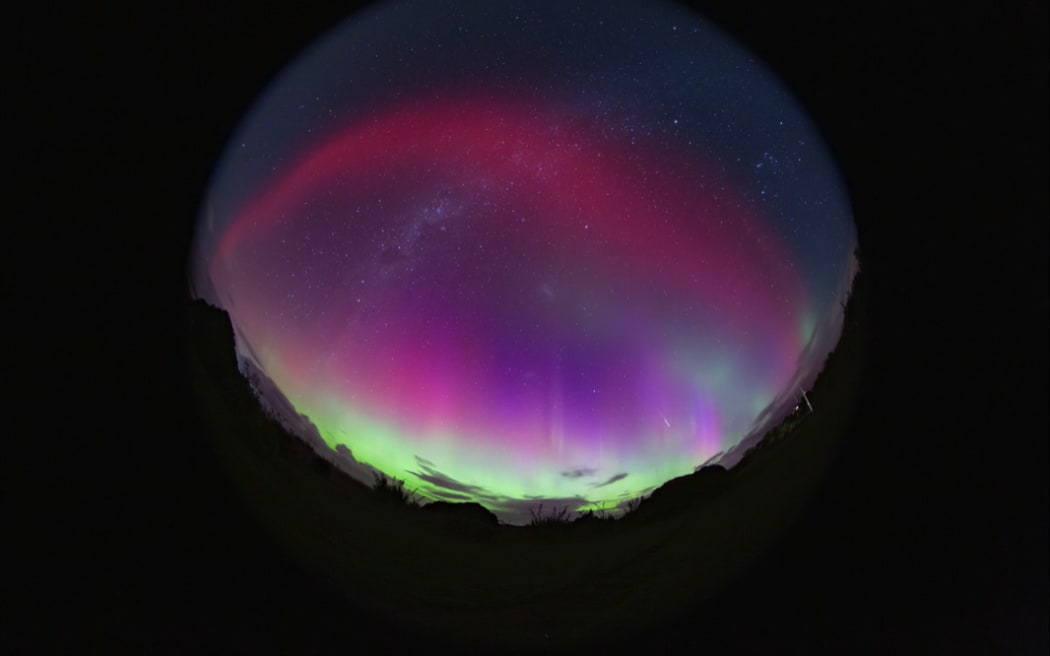When Dr Ian Griffin spotted some strange activity in Dunedin’s night sky on St Patrick’s Day in 2015, he knew he had to capture it.
The astronomer raced around the region to try and photograph it properly, in the process earning himself a speeding ticket.
It turns out what Dr Griffin captured was the first direct observation of rare auroral activity, which may cast new light on the complex magnetic interactions in the near-Earth space environment.

Rainbow of the Night - the first direct observation of a SAR arc evolving into STEVE Photo: Dr Ian Griffin
Dr Griffin tells Kim Hill that it was most incredible night he’d ever seen in nine years of chasing auroras in New Zealand.
“On this particular night, I was out because there was an enormous solar storm and it had stirred up the Earth's magnetic field and there was an incredible aurora going on and I ran out to try and photograph that, which was exciting enough, but when I set up my cameras… overhead there was this really weird thing going on in the sky.
“Any aurora hunter or chaser will say you don’t see stuff overhead very often.”
He says it was also odd because it was an intense red and our eyes aren’t usually sensitive to that colour, so this had to be very bright to be visible.
“It turns out the red arch that I saw is something called a Stable Aurora Red, and they’re quite common, but they’re normally invisible.
“It turns out this particular solar storm was so powerful that it stirred up even more activity in the Earth’s atmosphere and magnetosphere than usual and it stimulated this red emission.
“What happened then was this red emission somehow got more and more and more concentrated, eventually forming a really fast-moving jet high in the Earth’s magnetosphere and that’s this other form of activity I captured.”
Over time, the redness had transformed into a beam light called STEVE (Strong Thermal Emission Velocity Enhancement) aurora.
“The STEVE itself is a very rare form of aurora and it’s only seen when there are enormous geomagnetic storms and it can tell us about the workings of the Earth’s magnetic field," Dr Griffin says.
Wanting to know more about this strange phenomenon, he posted his observations on YouTube to ask if anyone had more information about it.

Dr Ian Griffin Photo: Supplied
About two years later, a scientist from NASA contacted him to ask if they could use his pictures to study it further.
“What was really interesting about it was we were lucky to have the satellite data at the same time … and they could measure the temperatures and the magnetic forces in the particular area of the Earth’s atmosphere.
“So the scientists managed to get some data and it turns out this particular STEVE that we saw, it’s got the fastest velocities, it was moving at about five kilometres per second, from east to west, and some of the highest ever temperatures seen, so it was about 6000 degrees Kelvin [or 5726.85 Celsius].”
His observations have formed the basis of a paper published in Geophysical Research Letters, co-authored by an international team, including scientists from Boston University, NASA, and the University of Calgary.
As we head into the next cycle of maximum solar activity, which has a direct correlation to auroras, Dr Griffin hopes more citizen scientists will be able to capture these events.
“What the set scientists working on this paper have said is look actually, we don’t have camera systems all over the world but we do have citizen scientists and they’re encouraging folks like myself and others to go out there, especially when there are really powerful auroral storms, to try and capture this particular type of event again because it’s really hard to study and the only way you can study it is when people go out and look for it.”
Dr Ian Griffin is director of Otago Museum and an honorary researcher at the Dodd-Walls Centre for Photonics and Quantum Technologies.

